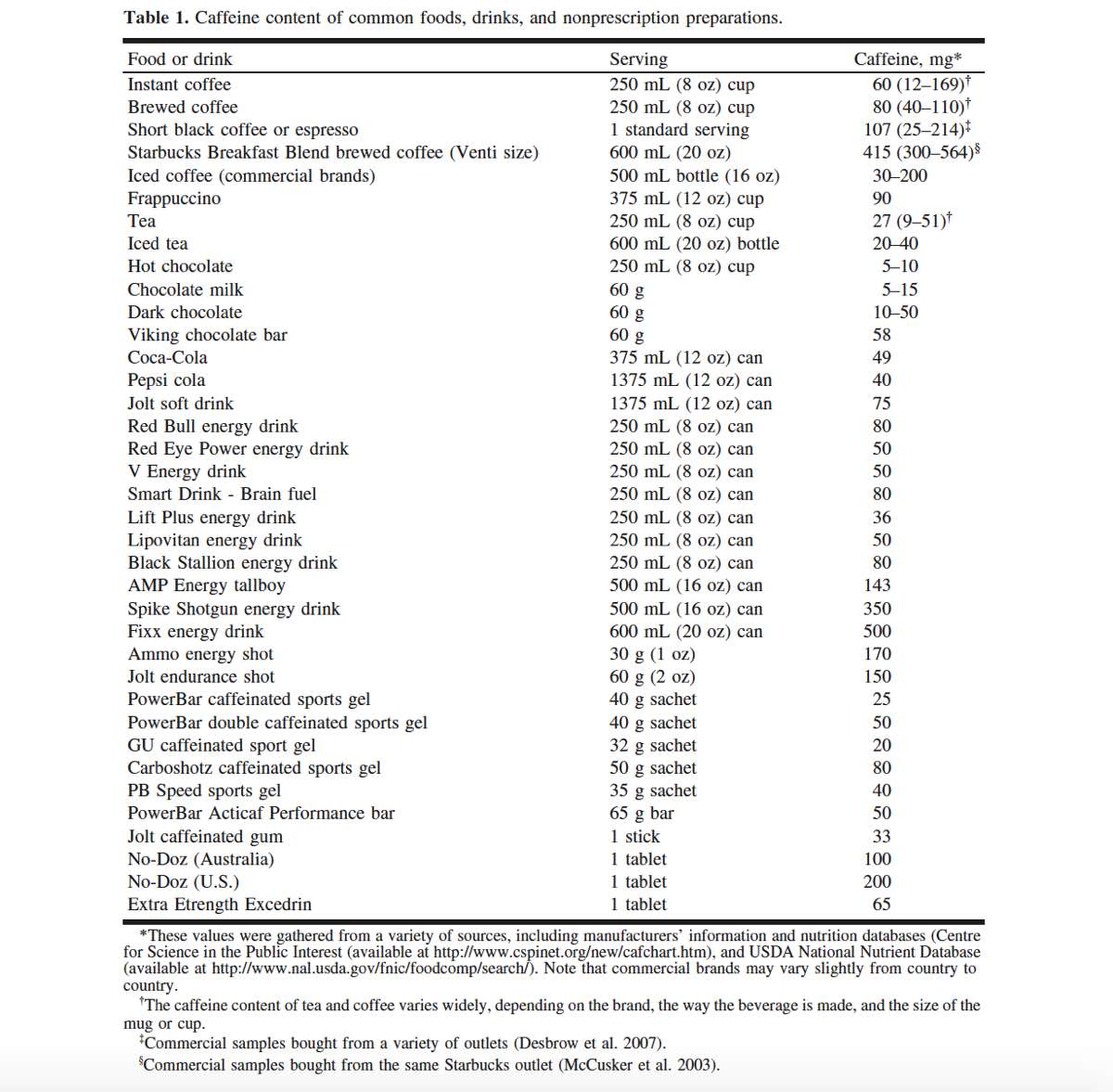Go-go juice, sweet nectar of the gods, java, cuppa joe, liquid energy, 1,3,7-trimethylxanthine, or however else you might refer to your morning brew, caffeine is a quintessential part of many of our days. In fact, it has been reported that approximately 90% of adults in the United States consume a moderate amount of caffeine (two to three eight-ounce cups of coffee) on a daily basis (1). That’s because most of us benefit from caffeine’s ability to stimulate our central nervous system, allowing us to be more alert and focused as we start our days.
It’s also because of these properties and others that caffeine has found a favorable place in sports nutrition, specifically as an ergogenic aid (something that is thought to boost athletic performance). Caffeine has been considered an ergogenic aid starting as far back as 1907 when Rivers and Webber determined that caffeine ingestion improved a person’s capacity to do muscular work (2). But like many other areas of applied exercise physiology, the conclusions don’t seem black and white. There was and still is apparent inter-subject variability, as scientific research shows that we all respond to caffeine a little differently.
In this article, we will address why those differences exist. We’ll also discuss how caffeine can improve endurance performance, and the best practices for caffeine use in training and racing. Though we’ll get into it in detail, in summary, current scientific consensus suggests ingesting two to six milligrams of caffeine per kilogram of body weight one hour before the start of competition.
Caffeine Absorption in the Body
Let’s first look at the biochemical underpinnings of how caffeine as a compound is physiologically absorbed by the body. Caffeine is so effective because it is quickly absorbed by your gastrointestinal tract and circulated in your tissues (3). Once in the liver, caffeine is ultimately metabolized (broken down) into three main metabolites (byproducts), paraxanthine (80%), theophylline (10%), and theobromine (4%).
Calling them byproducts might make these metabolites sound unimportant, but that’s hardly the reality. Paraxanthine helps to break down fat for energy utilization in your bloodstream, and it also can reduce inflammation and raise blood epinephrine (a hormone that energizes you) levels. Theophylline has been shown to also reduce inflammation and improve concentration. Finally, theobromine vasodilates (opens) your blood vessels, which ultimately increases the flow of oxygen and nutrients to your brain and muscles. This vasodilation also increases the kidneys’ filtering process, which is where the sometimes-present diuretic (increased-urination) effect of caffeine might come from.
This process is so fast that elevated caffeine levels can be detected in the bloodstream 15 to 45 minutes after you consume it. The concentration peaks approximately 60 minutes after ingestion, a fact that is important for timing your caffeine consumption to boost athletic performance. Three to six hours has always been thought of as the typical half-life (the amount of time it takes a substance’s concentration to reach half its original value) of caffeine in the body, but we’ll learn later in this article that your genetics greatly impact this time. It’s that very reason that some of us can ingest coffee at any time of day and be totally fine, whereas others cannot drink coffee after midday without having difficulties sleeping at night.
Finally and I think most interestingly, because caffeine is lipid soluble (has the ability to dissolve in fat), caffeine can cross the blood-brain barrier without difficulty (3, 6). Because of this ease of movement across all the cellular membranes in our bodies, caffeine has a profound impact on our central nervous system.
The Mechanisms of Caffeine
Now that we understand how caffeine is absorbed physiologically in our body, we can begin to understand how caffeine may improve our running performance. I say ‘may’ because although there is a growing consensus on the most likely mechanisms by which caffeine affects us, a lot remains unclear.
These are the three most likely means by which caffeine improves performance:
- Caffeine increases the mobilization of intracellular calcium in your muscles by inhibiting calcium uptake from the sarcoplasmic reticulum (the calcium storage center in muscle cells). This makes more calcium available, which aids in continuing muscle contractions.
- Caffeine increases the release of free fatty acids into our bloodstream to be utilized as fuel, allowing us to ‘save’ some glycogen for later.
- The most likely reason that caffeine aids performance is that it decreases feelings of fatigue. Caffeine acts as an antagonist (direct competition) of the neurotransmitter adenosine by binding directly to the adenosine receptors that are found throughout our bodies, specifically the A1 and A2a receptors. This blunts the effects of adenosine, whose role includes promoting sleep and suppressing arousal (4).
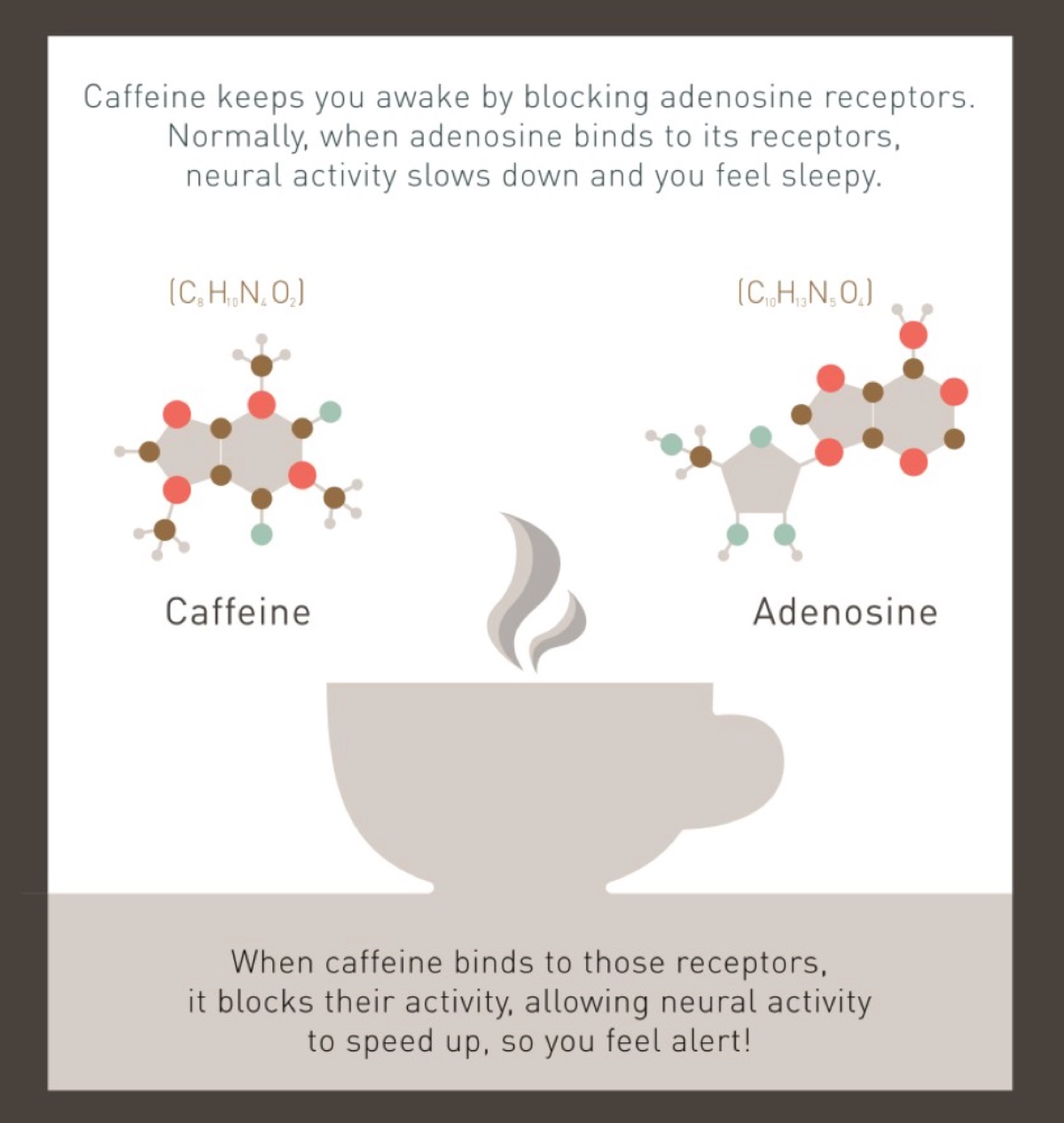
Caffeine binds directly to adenosine receptors, preventing adenosine from ‘slowing us down.’ Image: Knowingneurons.com
Without caffeine literally boxing out adenosine, we’d succumb to the normal effects of adenosine on our central nervous system. Typically, adenosine slowly accumulates throughout the course of the day, but during exercise when there is not enough oxygen to generate more adenosine triphosphate (an energy source), adenosine accumulates more rapidly. Adenosine not only can decrease feelings of alertness but it can also increase central fatigue. All of this negatively impacts your ability to perform athletically. It turns out that adenosine down regulates various neurotransmitters (specific chemical transmitters of a nerve impulse) including dopamine (we’ll talk about this in just a moment), serotonin (important in mood), glutamate (important for memory and learning), acetylcholine (important signaler for muscle contractions), and norepinephrine (important in the fight-or-flight response) (5, 6).
In the case of endurance performance, the primary mover here is dopamine. Dopamine is essential for regulating behavioral activation, and more importantly, effort-based behavior processing in the brain. Essentially, what caffeine and its metabolites do by blocking adenosine are to decrease our feelings of amotivation and improve our willingness to exert greater effort during exercise and even decrease our level of perceived exertion! Dopamine is a reward-happy neurotransmitter that can increase reward-motivated behavior and is often linked to things like addiction.
Additionally, there are more adenosine receptors in type I muscle fibers (slow-twitch muscle fibers) and this is one of the main reasons why caffeine seems to be more effective in endurance performance as compared to shorter sprint or strength efforts (1).
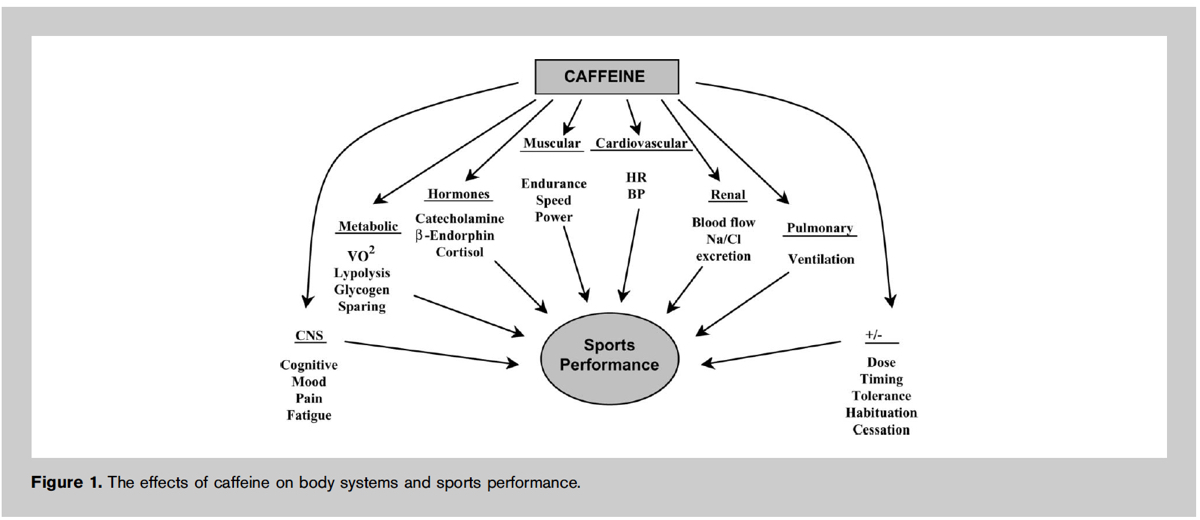
A breakdown of caffeine’s influences on sports performance by body system. Not all of these influences are positive, such as the increased excretion of Na/Cl (salt). It should additionally be noted that catecholamines are a class of amines which include neurotransmitters such as epinephrine and dopamine. Lipolysis is the breakdown of fats and lipids that release fatty acids into the bloodstream to be utilized as energy, thus sparing glycogen. Also caffeine ingestion does not affect absolute Vo2max values, but can influence Vo2max tests by increasing time to exhaustion (8).
That seems fairly straightforward, right? Ingest caffeine, don’t get tired, perform better. In fact, performance has been shown to improve by 3 to 7% in time-trial performances up to two hours in length (9).
Not so fast, though. Hah, get it?! Research has also shown that not everyone’s performance increases with caffeine use. A review of 20 different research papers that utilized a double-blind (both research and test participants don’t know which substance they are taking) time-trial performance-based study found that 33% of the participants had unchanged results between the caffeine and placebo trials or had a decrease in performance with caffeine ingestion (5). Where does this variation come from?
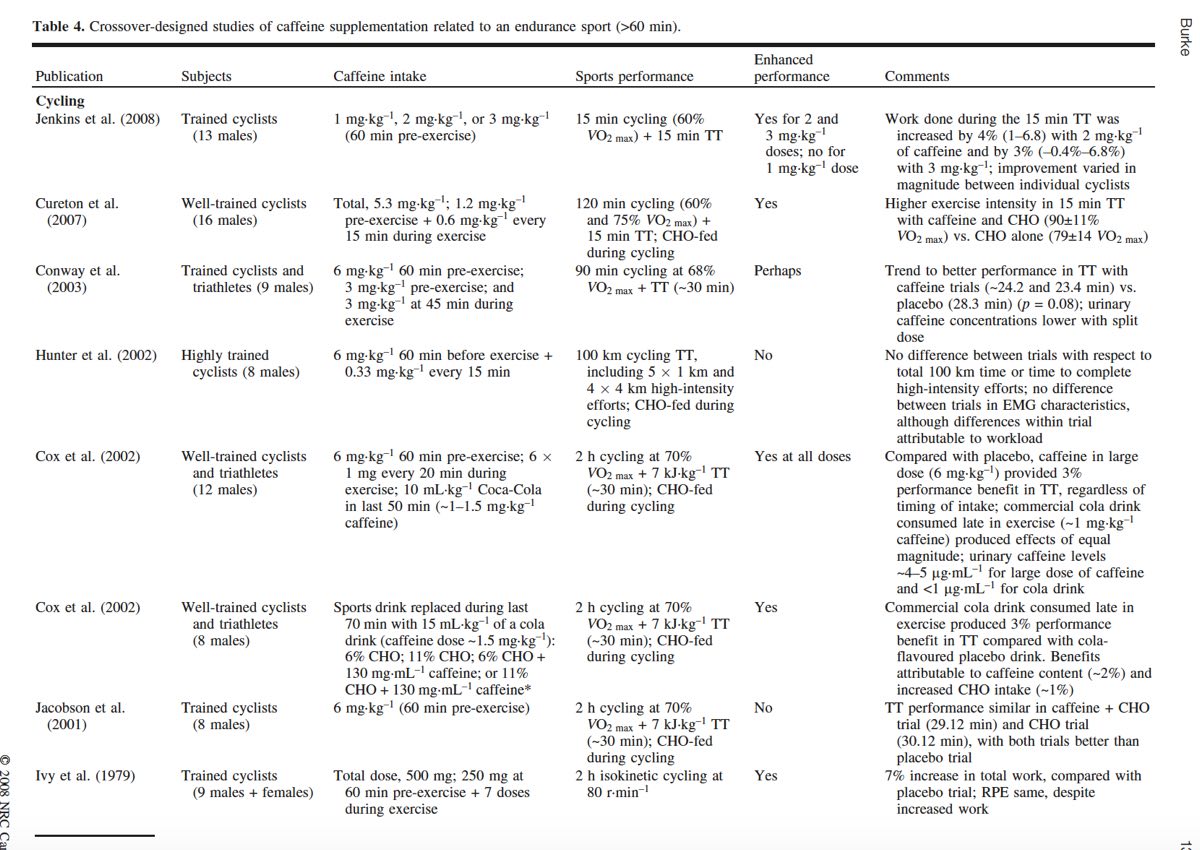
A table showing a summary of some studies looking at cycling-performance increases with moderate caffeine ingestion 60 minutes pre-exercise test. Most tests showed an improvement between 3 to 7% above placebo trials (9).
Numerous things affect caffeine metabolism. These likely include smoking, dietary vegetable intake (diets high in cruciferous vegetables increase caffeine metabolism and shorten caffeine’s half-life by about 20%), oral contraceptive use (limits caffeine’s effect on calcium concentration intramuscularly), pregnancy (caffeine metabolism slows down), menstrual-cycle stage, age (less of the liver enzyme responsible for metabolizing caffeine is produced, slowing caffeine metabolism), and hormone-replacement therapy.
Additionally, other factors relating to how caffeine is ingested are more controllable but can still affect caffeine effectiveness. These include caffeine dose, source, timing, time of day, and your training status. Expectancy is another booster of the ergogenic properties of caffeine. What this means is that if you think you are ingesting caffeine, you often have an additional performance boost, or if you are taking a placebo that you think has caffeine in it, you can get a boost as well (12).
Finally, the last and likely most important component for caffeine metabolism is genetics.
It’s in Your Genes
With the advent of mainstream genetic testing, all that stands between us and our genome being sequenced is a tube of saliva and paying a direct-to-consumer company to do it. One of the many interesting things that has come out of genome sequencing beyond the scope of major medical breakthroughs is learning more about our own genotypic (our genetic composition) and phenotypic (the result of our genotypes interacting with the environment) individuality.
When it comes to caffeine metabolism, the deciding factor might just be your genes, specifically the genes CYP1A2 (rs762551) and ADORA2A (rs5751876).
Caffeine and the CYP1A2 Gene
CYP1A2 is an enzyme found primarily in your liver and it is responsible for greater than 90% of all caffeine metabolism (5, 6). One small change to the gene responsible for CYP1A2 and suddenly your ability to metabolize caffeine is greatly impacted.
There are two varieties (alleles) of this gene, CPA1A2*1A, which codes for fast caffeine metabolism, and CPA1A2*1F, which codes for slow caffeine metabolism. If you inherited two ‘fast’ alleles from your parents, you are known as A/A and classified as a fast metabolizer, whereas if you inherited one ‘fast’ allele and one ‘slow’ allele, you are known as C/A, meaning you have a moderate capacity to metabolize caffeine. Finally, if you inherited two ‘slow’ alleles, you are known as C/C, which would make you a slow metabolizer (5).
Although research has so far produced some mixed results, it would appear that being a fast metabolizer (A/A) allows you to get the largest benefit from caffeine whereas the slow metabolizers (C/C) sometimes see no positive and even a negative impact on performance with caffeine ingestion (5, 6). So far in research, the intermediate metabolizers (C/A) seem to be intermediate, with research participants improving their time-trial performances with caffeine ingestion but to a lesser degree than the fast metabolizers (A/A). The thought with these intermediate and slow metabolizers is that the timing of the caffeine ingestion might be the culprit since their slow caffeine metabolism causes blood values to peak more slowly and to stay in the system longer.
The literature presently states that, on average, 40% of the general population carries the A/A genotype, 50% carries the C/A genotype, and 10% carries the C/C genotype (5).
Another recent concern with these genetically determined rates of caffeine metabolism is that intermediate and slow caffeine metabolizers who are moderate to heavy caffeine consumers (three-plus cups of coffee a day) might be more susceptible to cardiac issues, particularly tachycardia (high heart rate) and atrial fibrillation (irregular heartbeats), and have even been linked to a higher chance of suffering from a nonfatal myocardial infarction (heart attack). All this likely stems from caffeine remaining in the system longer (6).
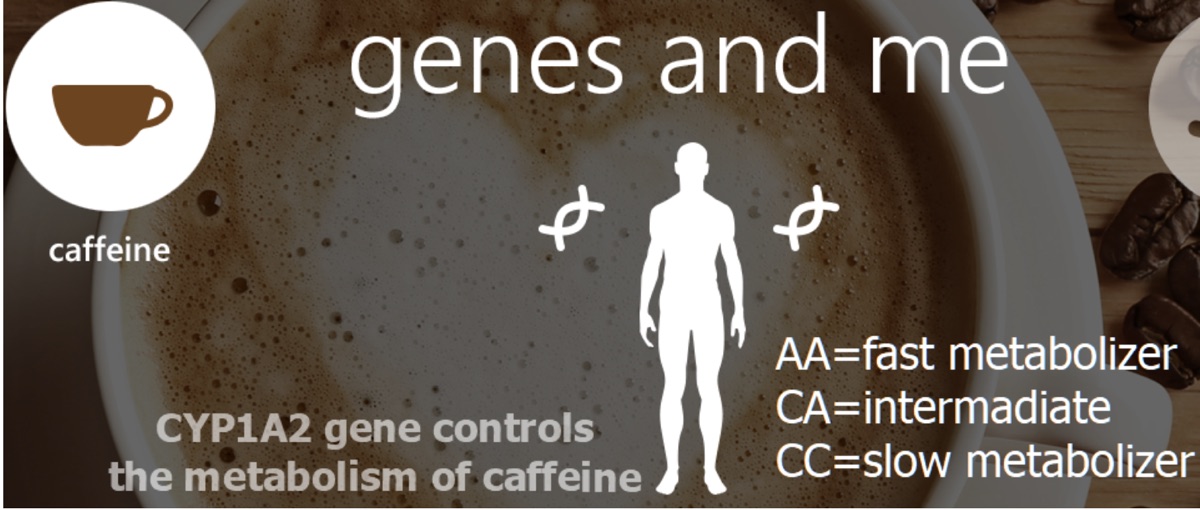
How different alleles affect caffeine metabolism. Image: Linkedin.com/pulse/genetics-caffeine-consumption-cyp1a2-gene-maria-vrânceanu/
Caffeine and the ADORA2A Gene
The other genetic component of caffeine metabolism is the ADORA2A gene and the C and T alleles. This gene codes for the amount of adenosine receptors you have (specifically A2a receptors), which we talked about earlier in this article. The alleles you carry determine your sensitivity to caffeine by controlling how many adenosine receptors you have.
The C allele seems to make caffeine bind more strongly, more effectively blocking adenosine. It is often attributed to sleep disturbances and even insomnia.
It appears that when T alleles are present, less receptors for adenosine are produced in the body and so caffeine ‘hits’ the receptors that are present more powerfully. Individuals carrying the T/T allele report more caffeine-induced anxiety. In mice studies, when the mouse has the T/T genotype, it will self-administer less caffeine due to the negative feedback from previous caffeine ingestion (10). Interestingly, people carrying the T/T genotype also generally self-report caffeine sensitivity.
Carrying matching pairs of alleles either C/C or T/T will heighten those attributes versus someone who has one of each allele (C/T).
Current estimations for ADORA2A genetic expression in the general population are that 45% of people have the C/T allele pairing while the T/T and C/C allele pairing are each approximately 20 to 30%.
Now that might all seem overwhelming and complicated, so what can you do to better use caffeine for running performance without spitting in a tube?
Caffeine’s Best-Use Practices
As we mentioned earlier, outside of genetics, there are a number of things you can do to help aid the efficiency of your caffeine metabolism and get the most out of your supplementation. Those things are caffeine dose, source, and timing.
When it comes to the amount of caffeine you want for a performance boost, more is not better. Although most literature would say anywhere from 3 to 9 milligrams of caffeine per kilogram of body weight (mg/kg BW) will do the trick, there are numerous studies (9, 3, 6) that do not find any greater of an increase in performance between 6 and 9 mg/kg BW and that higher doses can lead to negative side effects including increased heart rate, palpitations, nausea, shakiness, and vomiting.
Harkening back to other articles in this column, in applied exercise physiology, we are always looking for the lowest possible dose that gets the positive results or adaptations we are looking for. In the case of caffeine ingestion, that would appear to be as small as 2 to 3 mg/kg BW for non-/low caffeine users and 3 to 6 mg/kg BW for habitual caffeine users (6). These two different values come from the consensus that the lowest effective dose is 2 to 3 mg/kg BW and the goal of avoiding negative side effects in non-/low caffeine users.
For example, I weigh 130 pounds or about 59 kilograms. As a low-caffeine person, I would shoot for 118 to 177 milligrams of caffeine pre-competition to best boost my athletic performance. This translates to somewhere around 12 to 16 ounces of black coffee depending on its strength.
When it comes to caffeine’s source, in research, the best performances recorded utilize pure caffeine in the form of capsules or powder dissolved in water. However, those caffeine doses are not always as easily accessible to the general public as they are to controlled research programs. In a study published in 2013, researchers set out to compare coffee and pure caffeine in the hope of shining a light on other forms of caffeine ingestion that would be more practical for a larger subset of athletes (14). What they found was that an equal amount of caffeine consumed in coffee had a pretty similar performance effect to pure caffeine, and even showed that ingesting decaffeinated coffee with a caffeine supplement still improved performance compared to the placebo. Why the decaf trial is important is that it helps to eliminate the worry that the chlorogenic acids (an abundant chemical compound found in coffee, including decaf coffee) were the limiting factor between regular coffee and ingesting pure caffeine (6).
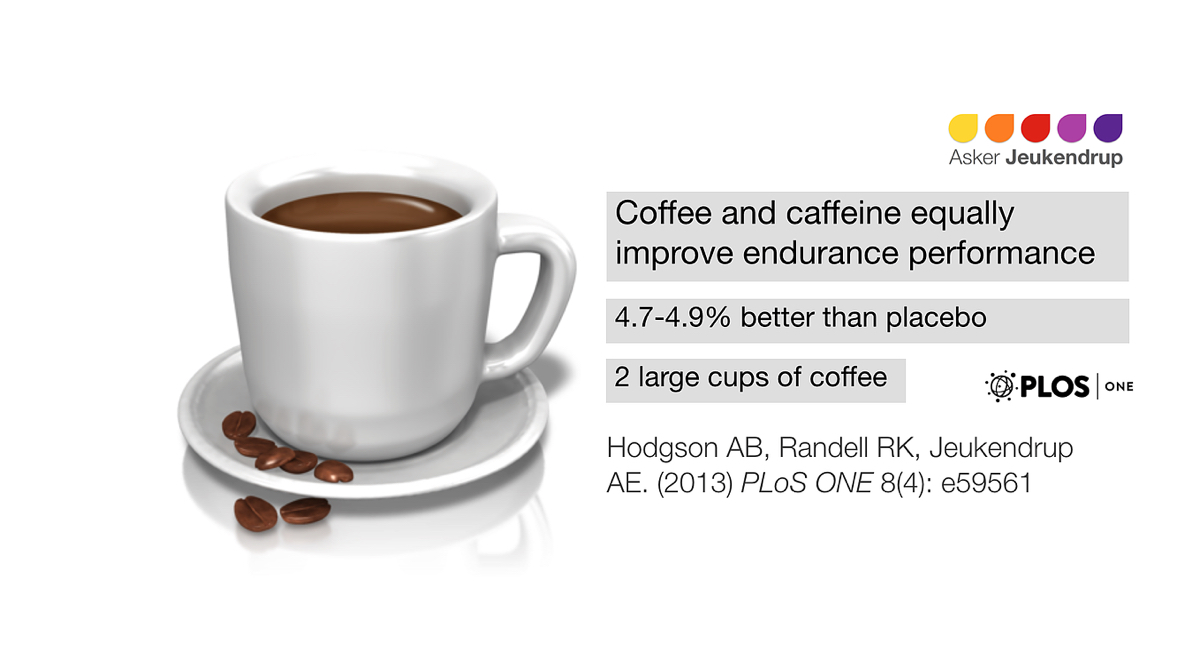
Independent of caffeine source (in this case coffee versus pure caffeine), caffeine increases performance by 4.7 to 4.9% above the placebo trial. Image: Mysportscience.com
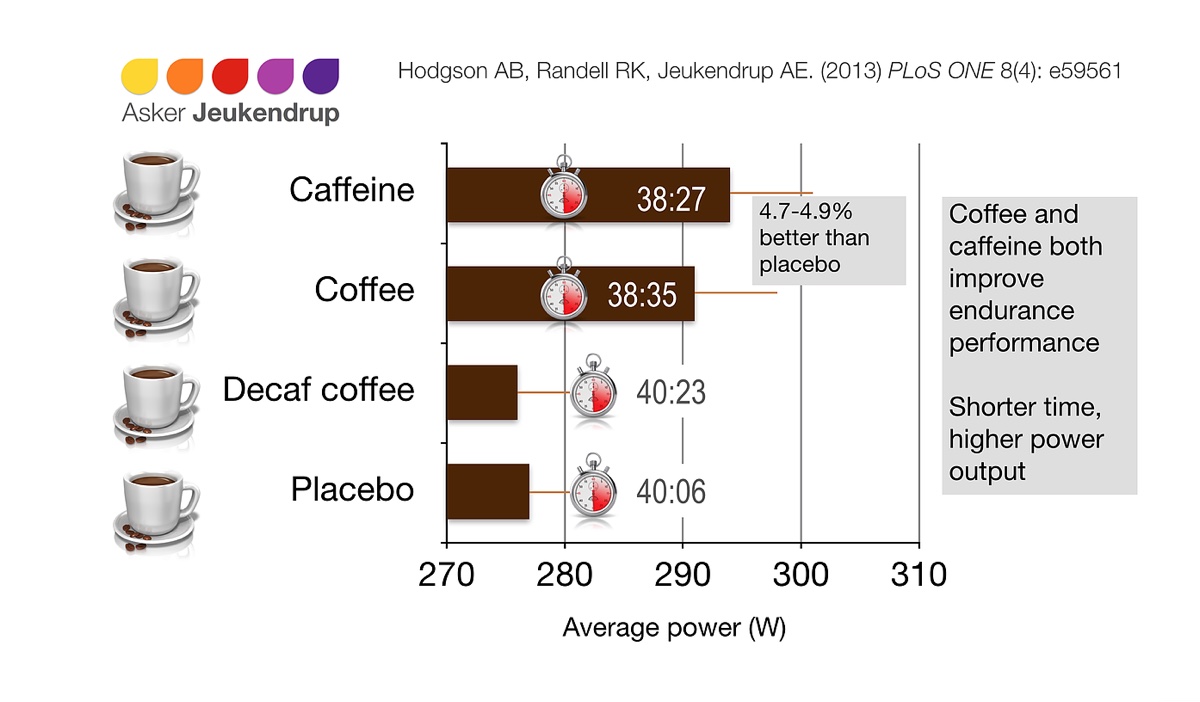
Both pure caffeine and coffee ingested pre-exercise improved time-trial times by 4.7 to 4.9%. Image: Mysportscience.com
Finally, and maybe most simply, let’s talk about timing. The current recommendation for caffeine ingestion is 60 minutes prior to a competition’s start because this is when the concentration of caffeine and its metabolites in our blood peak and are binding to the most adenosine receptors.
The secondary timing question here for ultrarunners is, since we run for so long, what about ingesting caffeine during competition? In exercise lasting up to two hours, a systematic review found that, on average, there was no difference between supplementing before versus during. However, they did find a difference when it came to supplementing before the event versus caffeine ingestion both before and during the event of 2.3 +/- 3.2% versus 4.3 +/- 5.3% increase in performance. Additionally, because caffeine’s half-life is only three to six hours in a majority of the population (the fast metabolizers), supplementing throughout the course of an ultramarathon may allow you to keep a level of caffeine and its metabolites that optimize their adenosine-receptor-binding properties.
Myth Busting
Caffeine is a Banned Substance
False.
Caffeine was once on the World Anti-Doping Agency (WADA) banned-substance list, between 1984 and 2004, but it is not currently banned. For a substance to garner a spot on WADA’s list, it needs to meet two of three criteria. Specifically, it must have the potential to increase performance, put an athlete’s health at stake, and/or violate the spirit of the sport. Because it’s such a widely consumed product, caffeine was a controversial add at the outset.
In order to differentiate between the casual ingestion of caffeine and the use of caffeine to garner performance results, WADA set up a urine threshold of 15 micrograms/milliliter (ug/mL), but quickly lowered it to 12 ug/ML in 1985. This cutoff threshold was controversial because the caffeine dose known to increase performance (3 to 6 mg/kg BW) was much lower than the amount of caffeine you would need to ingest to produce a urine sample with a caffeine concentration above the threshold. Another issue with monitoring caffeine concentrations in urine is that there is a lot of variation between urine samples independent of how much caffeine a subject ingests.
In 2004, caffeine was removed from the WADA list, but it remains banned at the threshold cap by the National Collegiate Athletic Association (NCAA) due to health concerns and is still on the WADA watch list so that they can monitor current trends in caffeine use without penalty to athletes (9, 11).
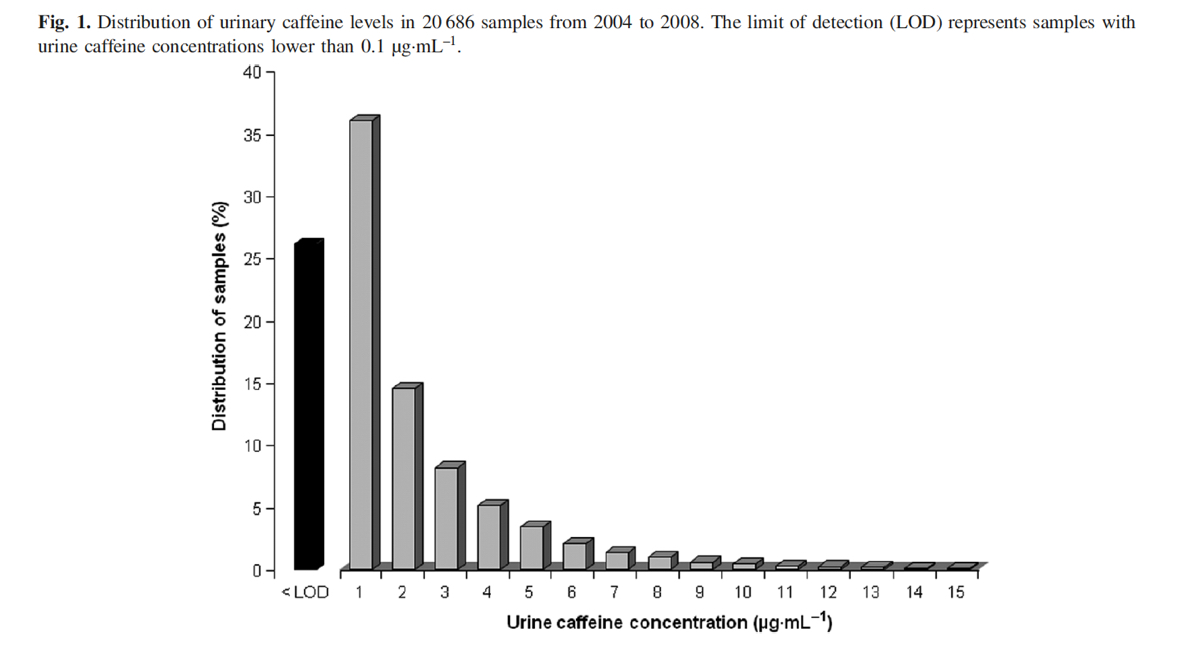
The percent of urine samples containing specific concentrations of caffeine collected by WADA during in-competition testing between 2004 and 2008 (11).
Caffeine Dehydrates You
Mostly false.
You’ve probably heard caffeine be called a diuretic. Indeed, caffeine does have a diuretic effect when consumed in massive doses of over 500 milligrams (16). You’ve likely also heard that if you are a regular coffee drinker, you likely have a tolerance to the diuretic effect of caffeine. This is also true. However, it appears that this tolerance is lost even with just four days of coffee withdrawal, indicating the likely role of habituation in limiting caffeine’s potential diuretic effect.
The biggest takeaway is that sticking to your regular caffeine consumption, assuming it’s not in excess of 500 milligrams, likely prevents caffeine from having a diuretic effect on you. For example, if you are a non-/low caffeine user, a high caffeine dose will likely produce an acute increase in urine volume, but a low to moderate dose of caffeine (within that recommendation of 2 to 3 mg/kg BW) should not (16).
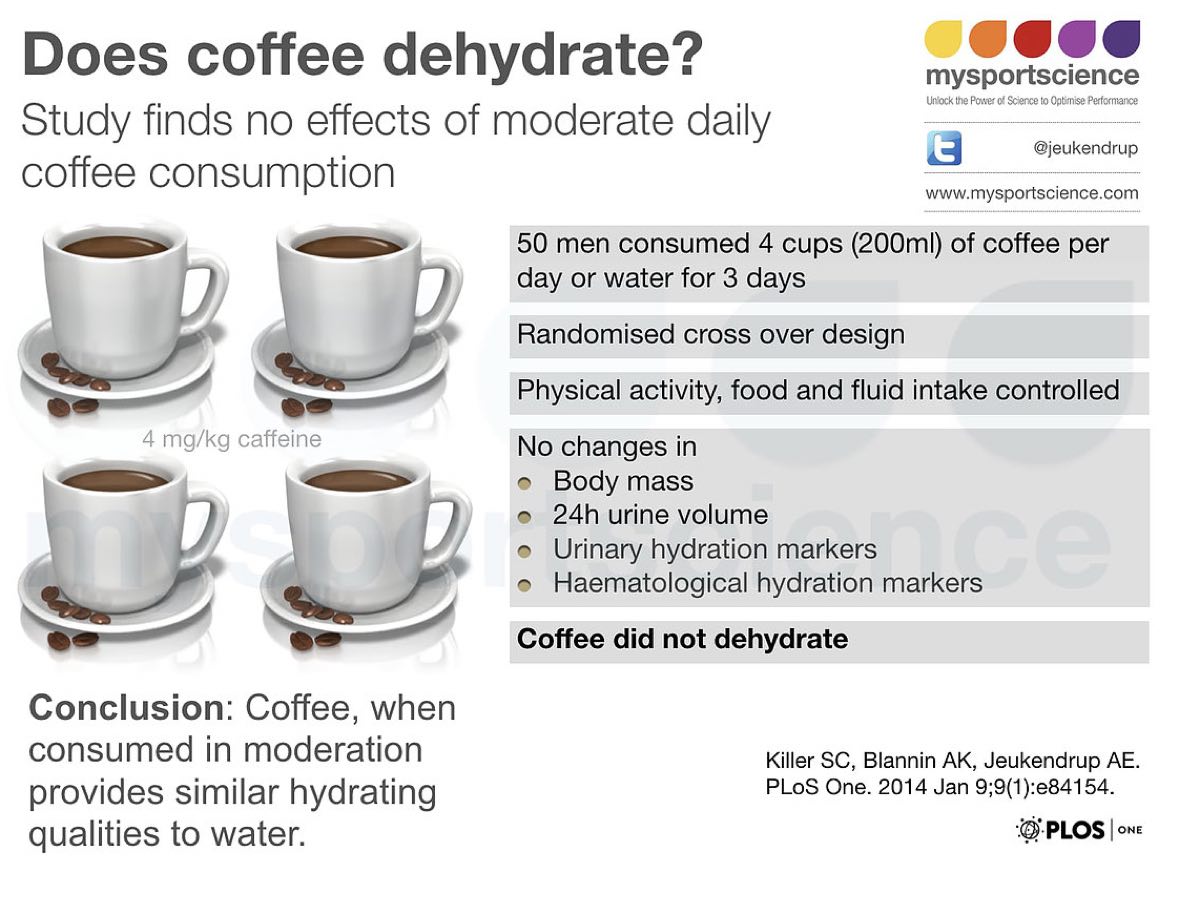
There was no significant difference between men drinking a moderate to high amount of caffeine or water for three days between body mass, urine volume, or urinary-hydration markers, suggesting caffeine is not dehydrating. Image: Mysportscience.com
Pre-Race Caffeine Withdrawal Produces Better Performance
False.
There has been a longstanding idea in many athletic circles that in order to most benefit from caffeine during a race, you need to stop using caffeine in the days/weeks before the event. Part of this belief likely came from the inter-subject variability of early caffeine research, wherein we attributed lower performance changes to caffeine habituation rather than the now-other-known factors that affect caffeine metabolism, namely genetics. However, some more recently published research will hopefully save you and your loved ones from your coffee-withdrawal symptoms!
In a paper published in 2017 looking at low, moderate, and high caffeine consumers in a cycling time trial, there were similar performance benefits for all three groups when given 6 mg/kg BW of caffeine pre-exercise test (13). That is, all the caffeine user types got a similar performance ‘bump,’ suggesting that caffeine habituation doesn’t play a role. If habituation did play a role, the moderate-to-high users should get less of an improvement bump than the non-/low caffeine users. Additionally, two other studies showed that there were no significant performance improvements when the athletes did a four-day, two-day, or 24-hour withdrawal prior to an exercise test compared to just being a habitual user. To be clear, habitual caffeine users and withdrawal users had similar performance increases (18, 19).

During three different exercise time trials (CON = control/no substance given, PLA = placebo given, CAF = caffeine given 6 mg/kg BW), there was a significant improvement in both the placebo and caffeine trials over the control trials, with caffeine trials being the fastest of all three tests. This shows that independent of normal caffeine ingestion state (habitual users or not), caffeine improves-time trial performance. Image: Mysportscience.com
Take-Home Messages
- We all respond to caffeine differently, so explore and experiment to get a sense of your personal sensitivity to caffeine.
- As a rule of thumb, 2 to 3 mg/kg BW for non-/low caffeine consumers and 3 to 6 mg/kg BW for moderate-to-high caffeine consumers 60 minutes prior to the start of your event is the target for boosting performance with caffeine.
- In the spirit of ultramarathons, try to notice how fast your body metabolizes caffeine, knowing that you can reintroduce more caffeine into the system as the initial dose is flushed out.
- Signs of too much caffeine (aside from an increased heart rate and palpitations) overlap with many other common ultrarunning problems, so if you begin to experience nausea, gastrointestinal distress, or anxiety, double check that you haven’t been solely fueling with deliciously caffeinated gels and drink mixes.
- The science is here to guide you, but experience is invaluable. You are an experiment of one.
Call for Comments (from Meghan)
- Would you describe yourself as a non-, low, medium, or high caffeine consumer? Where do you get your caffeine, how much of that source do you have in a day, and what is your consumption schedule?
- Have you ever considered your level of sensitivity to caffeine, as well as how and when your level of sensitivity changes? For those who have a high sensitivity, can you describe what caffeine feels like to you?
- Can you tell if caffeine enhances your athletic performance, has no effect, or has a negative effect? What signs have you noticed or felt in yourself which led you to this belief? And what about ‘performance’ in the rest of your life, such as your work and hobbies?
References
- Astorino, T. A., & Roberson, D. W. (2010). Efficacy of Acute Caffeine Ingestion for Short-term High-Intensity Exercise Performance: A Systematic Review. Journal of Strength and Conditioning Research,24(1), 257-265. doi:10.1519/jsc.0b013e3181c1f88a
- Rivers, W. H., & Webber, H. N. (1907). The action of caffeine on the capacity for muscular work. The Journal of Physiology,36(1), 33-47. doi:10.1113/jphysiol.1907.sp001215
- Goldstein, E. R., Ziegenfuss, T., Kalman, D., Kreider, R., Campbell, B., Wilborn, C., . . . Antonio, J. (2010). International society of sports nutrition position stand: Caffeine and performance. Journal of the International Society of Sports Nutrition,7(1), 5. doi:10.1186/1550-2783-7-5
- Nehlig, A., & Debry, G. (1994). Caffeine and Sports Activity: A Review. International Journal of Sports Medicine,15(05), 215-223. doi:10.1055/s-2007-1021049
- Southward, K., Rutherfurd-Markwick, K., Badenhorst, C., & Ali, A. (2018). The Role of Genetics in Moderating the Inter-Individual Differences in the Ergogenicity of Caffeine. Nutrients,10(10), 1352. doi:10.3390/nu10101352
- Pickering, C., & Kiely, J. (2017). Are the Current Guidelines on Caffeine Use in Sport Optimal for Everyone? Inter-individual Variation in Caffeine Ergogenicity, and a Move Towards Personalised Sports Nutrition. Sports Medicine,48(1), 7-16. doi:10.1007/s40279-017-0776-1
- Bhalla, R., & Gupta, M. (2018). DOES MODERATE CAFFEINE CONSUMPTION CAUSES DIURESIS? – A SYSTEMATIC REVIEW. International Journal of Recent Innovation in Food Science and Nutrition,1(1).
- Sökmen, B., Armstrong, L. E., Kraemer, W. J., Casa, D. J., Dias, J. C., Judelson, D. A., & Maresh, C. M. (2008). Caffeine Use in Sports: Considerations for the Athlete. Journal of Strength and Conditioning Research,22(3), 978-986. doi:10.1519/jsc.0b013e3181660cec
- Burke, L. M. (2008). Caffeine and Sports Performance. Applied Physiology Nutrition and Metabolism,33, 1319-1334.
- Yacoubi, M. E., Ledent, C., Parmentier, M., Costentin, J., & Vaugeois, J. (2005). Reduced appetite for caffeine in adenosine A2A receptor knockout mice. European Journal of Pharmacology,519(3), 290-291. doi:10.1016/j.ejphar.2005.07.022
- Coso, J. D., Muñoz, G., & Muñoz-Guerra, J. (2011). Prevalence of caffeine use in elite athletes following its removal from the World Anti-Doping Agency list of banned substances.Applied Physiology, Nutrition, and Metabolism,36(4), 555-561. doi:10.1139/h11-052
- Saunders, B., Oliveira, L. F., Silva, R. P., Painelli, V. D., Gonçalves, L. S., Yamaguchi, G., . . . Gualano, B. (2016). Placebo in sports nutrition: A proof-of-principle study involving caffeine supplementation.Scandinavian Journal of Medicine & Science in Sports,27(11), 1240-1247. doi:10.1111/sms.12793
- D.S. Gonçalves, V.D.S. Painelli, G. Yamaguchi, L.F.D. Oliveira, B. Saunders, R.P.D. Silva, et al., Dispelling the myth that habitual caffeine consumption influences the performance response to acute caffeine supplementation, Journal of Applied Physiology. 123 (2017) 213–220. doi:10.1152/japplphysiol.00260.2017.
- B. Hodgson, R.K. Randell, A.E. Jeukendrup, The Metabolic and Performance Effects of Caffeine Compared to Coffee during Endurance Exercise, PLoS ONE. 8 (2013). doi:10.1371/journal.pone.0059561.
- S. Ganio, J.F. Klau, D.J. Casa, L.E. Armstrong, C.M. Maresh, Effect of Caffeine on Sport-Specific Endurance Performance: A Systematic Review, Journal of Strength and Conditioning Research. 23 (2009) 315–324. doi:10.1519/jsc.0b013e31818b979a.
- C. Killer, A.K. Blannin, A.E. Jeukendrup, No Evidence of Dehydration with Moderate Daily Coffee Intake: A Counterbalanced Cross-Over Study in a Free-Living Population, PLoS ONE. 9 (2014). doi:10.1371/journal.pone.0084154.
- Mcdanell, R., Henderson, L., Russell, K., & Mclean, A. (1992). The Effect of Brassica Vegetable Consumption on Caffeine Metabolism in Humans.Human & Experimental Toxicology,11(3), 167-172. doi:10.1177/096032719201100304
- Desbrow, B., Irwin, C., Ellis, A., Okeeffe, B., Grant, G., & Leveritt, M. (2010). Caffeine Withdrawal and High Intensity Endurance Cycling Performance.Medicine & Science in Sports & Exercise,42, 106. doi:10.1249/01.mss.0000385973.25825.7e
- Soeren, M. H., & Graham, T. E. (1998). Effect of caffeine on metabolism, exercise endurance, and catecholamine responses after withdrawal.Journal of Applied Physiology,85(4), 1493-1501. doi:10.1152/jappl.1998.85.4.1493
